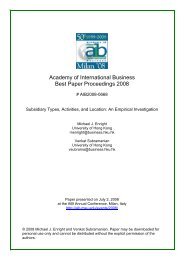AIB 2012 Conference Proceedings - Academy of International ...
AIB 2012 Conference Proceedings - Academy of International ...
AIB 2012 Conference Proceedings - Academy of International ...
Create successful ePaper yourself
Turn your PDF publications into a flip-book with our unique Google optimized e-Paper software.
SUNDAY<br />
Session: 1.3.5 - Competitive<br />
Track: 7 - Emerging Economies<br />
FDI, MNEs and Emerging Economy Institutions<br />
Presented On: July 1, <strong>2012</strong> - 13:00-14:15<br />
Chair: Hemant Merchant, USF – St. Pete<br />
Do Institutional Fields for Outward Foreign Direct Investment from Emerging Markets Matter A Case for<br />
Theoretical Extension<br />
Svetla Trifonova Marinova, Aalborg University<br />
John Child, University <strong>of</strong> Birmingham<br />
Marin Marinov, University <strong>of</strong> Gloucestershire<br />
This paper examines institutional formation and institutional entrepreneurship relating to outward foreign direct<br />
investment (OFDI) in China and Russia since the beginning <strong>of</strong> their market-oriented economic reforms. It<br />
focuses on the stages <strong>of</strong> OFDI institutional development during these periods <strong>of</strong> major system change, with<br />
particular reference to both the processes and outcomes involved. In each country, the state and its agencies<br />
were the principal institutional entrepreneurs in developing the OFDI system. Consequently, the development <strong>of</strong><br />
OFDI institutions depended heavily on the extent to which state policy was consistent in supporting their<br />
regulative, normative and cognitive pillars. The paper concludes by advancing theoretical propositions and an<br />
analytical framework which posits various consequences <strong>of</strong> political and economic continuity for OFDI<br />
institutional development, moderated by the level <strong>of</strong> institutional entrepreneurship coming from governmental<br />
and business sources. (For more information, please contact: Svetla Trifonova Marinova, Aalborg University,<br />
Denmark: svetla@business.aau.dk)<br />
How Do Sub-National Institutional Constraints Impact Foreign Firm Performance<br />
Xiaoying Li, Brunel University<br />
Laixiang Sun, SOAS, University <strong>of</strong> London<br />
This paper examines the impact <strong>of</strong> sub-national institutions on the performance <strong>of</strong> foreign firms in China.<br />
Building on institutional theory, we envisage that the negative effect <strong>of</strong> sub-national institutional constraints is<br />
moderated by firm size and age, entry mode, and market orientation. Our hypotheses are tested on a largefirm-level<br />
dataset <strong>of</strong> about 29,000 foreign firms in 120 cities in China within the period <strong>of</strong> 1998-2005. We find<br />
that firm size and age both have a diminishing positive impact on foreign firm performance; moreover, there is<br />
a U-shaped relationship between firm age and foreign firm performance in cities with higher level institutional<br />
constraints. We also find that joint ventures help mitigate the negative impact <strong>of</strong> sub-national institutional<br />
constraints on foreign firm performance when the level <strong>of</strong> institutional constraints is higher. (For more<br />
information, please contact: Xiaoying Li, Brunel University, United Kingdom: xiaoying.li@brunel.ac.uk)<br />
Multiple Roles <strong>of</strong> Multinational Corporations, Local Institutions and Indigenous Technological Efforts in an<br />
Emerging Economy<br />
Zhenzhen Xie, Hong Kong University <strong>of</strong> Science and Technology<br />
Getting engaged in competitive international markets motivates exporting firms to enhance their technological<br />
capabilities and invest in research and development (R&D). However, R&D investment is one <strong>of</strong> several ways to<br />
enhance technological capabilities. When there are other sources <strong>of</strong> knowledge available, exporters' tendency to<br />
invest in R&D may be weakened. In the paper, three other sources <strong>of</strong> knowledge are identified: 1) multinational<br />
corporations (MNC) as customers, 2) MNCs as parents, and 3) FDI in a local industry. An analysis on 5,595<br />
<strong>AIB</strong> <strong>2012</strong> <strong>Conference</strong> <strong>Proceedings</strong><br />
Page 37

















